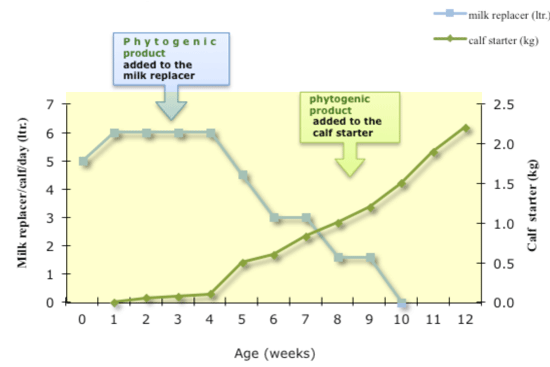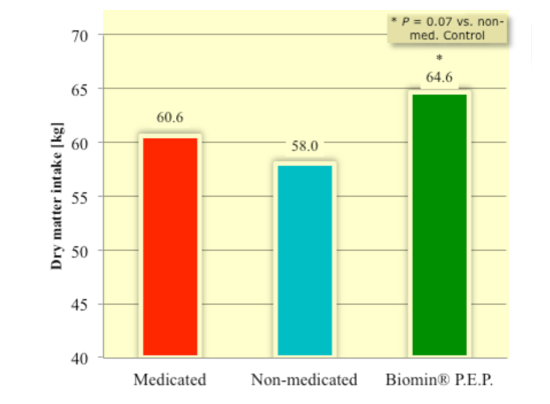



What Phytogenic Additives Can Do For Calves?
Ahmed Aufy, Tobias Steiner and Mike Watkins, from Biomin, look at the relatively new feed additives, phytogenic additives and their potential use in calf diets.Introduction
Heifer calves are future cows. Therefore, they represent an investment in the future productivity and profitability of dairy farms. Special attention should be given to protect these young animals from intestinal and respiratory diseases to help assure their proper development from the pre-ruminant calf to the lactating dairy cow with a fully functional rumen.
Calves experience numerous stresses in the first few weeks of life. The USDA 2007 NAHMS report, revealed that 7-10 per cent of newborns die during the milk feeding period before weaning. The calves’ diet changes several times during this six to eight week period. In the first 24 hours colostrum is their food, which provides not only their primary source of nutrients but also their source of protective antibodies. Then, their diet is changed to milk (hospital or waste milk which vary in nutrient composition) or milk replacer. Even the milk or milk replacer diet can be a stressor because in some situations it is deficient in the nutrients needed to meet the requirements for maintenance, much less growth. As the calf grows, grain based starter feeds are given in increasing amounts. In some calf feeding programmes roughages are introduced, along with the starter feed, ostensibly to promote rumen development. At weaning all milk is withdrawn and only starter or starter and roughage are provided.
Still, with all these dietary changes calves are expected to grow rapidly and convert feed efficiently while maintaining sound health. Not surprising, their digestive tract can be easily overtaxed. Consequently, growth is negatively affected because undernourished calves direct most of the nutrients absorbed towards surviving by supporting their critical biological processes during this stressful period. According to the NAHMS report over half (56 per cent) of the preweaning mortality resulted from scours, diarrhea or other digestive problems. In the past, these challenges were largely controlled by the use of sub-therapeutic use of antimicrobial growth promoters (AGPs). Notably, however, several countries have moved away from using AGPs in animal production, including calf rearing, due essentially to consumer’s concerns. The most recent example is the US, where the sub-therapeutic use of Neo-Terra (Neomycin and Terramycin), a practice that was widely used for decades, was prohibited in 2010. Such changes have created the need for alternatives that are capable of helping calves maintain good health and to reach their growth potential.
Can phytogenic additives effectively replace AGPs?
Simply put, phytogenic products are a relatively new group of natural feed additives derived from plants, mainly spices and herbs. Although phytogenic products are an ancient class of natural feed additives, day by day, significant knowledge is gained regarding their biological importance and their modes of action in helping maintain animal health and performance. In the previous decade, phytogenic additives received mixed results. Now, with more research, especially on their use in monogastric animals, mainly swine and poultry, but also in young calves, more of these questions are being answered. The elucidated bioactive substances in phytogenic additives have shown beneficial effects in maintaining feed intake and in aiding digestion and feed utilisation. Moreover, various phytogenic products have been shown to have antioxidant, antimicrobial and antifungal properties.
Application of phytogenic products in calves
New born calves, digestive function wise, are not unlike baby pigs in the food they consume, how they digest that food and receive the nutrients from that food. For newborn calves, phytogenic products can be given in two ways: (1) in the milk and/or (2) in the grain based starter feeds (Figure 1).
Figure 1. Routes of application of phytogenic products in calves.

Returning to the main question about the efficacy of phytogenic products as alternatives to antibiotics in animal feeding, an experiment was conducted at the Calf and Heifer Research unit at the University of Minnesota, Waseca, Minnesota (U.S.), to evaluate the impact of milk replacer supplemented with a phytogenic product fed to Holstein heifer calves, (Chester-Jones et al., 2010) which resulted in some interesting findings that are presented in this article.
Picture 1. Calf pen in the experimental unit of University of Minnesota (2010)

The performance of calves fed a phytogenic product (Biomin® P.E.P. sol powder) in the milk replacer and no phytogenic products in the calf starter was compared to that of calves fed either a medicated milk replacer (sub-therapeutic Neo-Terra) and a medicated calf starter (monensin), or calves fed a non-medicated milk replacer and non-medicated calf starter. The calves were kept in individual pens in a naturally ventilated calf barn at the Southern Research and Outreach Center throughout the trial. (Picture 1).
Phytogenic products and growth rate
It is well established that phytogenic products exert many actions within the digestive system. One of the most important is the enhanced production of saliva, bile and mucus, as well as digestive enzymes, which maximise feed digestion for nutrient absorption. Moreover, phytogenic products were found to have antimicrobial properties because the biologically active compounds have the ability to penetrate the bacterial cellular membrane, which leads to the release of cellular contents and cell death. As a consequence, the competition for nutrients between the animal and its intestinal microflora is reduced, hence increasing the potential for nutrient absorption. In the present study it was found that supplementing the milk replacer with phytogenic products resulted in increased calf body weight (Figure 2). At weaning (42 days) calves fed phytogenics in the milk replacer were as heavy as the calves in the positive control group (medicated milk replacer plus medicated starter). At day 56, calves that received phytogenic products in the milk replacer gained more than calves in either of the other two groups:
- +3.9 kg vs. non-medicated group
- +1.9 kg vs. medicated group
Figure 2. Effect of milk replacer supplementation with Biomin® P.E.P. on calf body weight (University of Minnesota, 2010)

Phytogenic products increase feed intake and improve feed efficiency
It’s no secret that the most important criteria in calf management and the first parameter to monitor is daily feed intake. Moreover, feed intake in this period of a calf’s life is very sensitive to different variables; for example a pronounced decrease in feed intake may be caused by improper ventilation, illness or inconsistent feeding regimens. The pre-weaning and weaning periods are very stressful for these young animals.
There are few facts regarding feed consumption that can be summarised as follows:
Figure 3. Effect of milk replacer supplementation with Biomin® P.E.P. on calf dry matter intake (University of Minnesota, 2010

- Excellent growth is observed at high intakes of milk replacer or starter diet.
- Feed intake by calves plays a crucial role in their growth and future performance.
- Starter diet consumption at an early age is important for the development of a functioning rumen, which also is needed to achieve optimal growth.
The chemical nature and flavoring properties of phytogenic products tends to increase ration palatability and hence feed intake. Also, phytogenic products’ act on the digestive system to enhance digestion and nutrient absorption which leads to better nutrient utilisation and improved feed conversion. The presents trial shows that a milk replacer supplemented with a phytogenic additive (Biomin® P.E.P. sol powder) increased feed intake. Calves fed the phytogenic product had a 6.6 kg greater total dry matter intake compared to the non-medicated group and 4 kg more than the calves fed the AGP medicated ration (Figure 3). Moreover, feed conversion was equivalent to that of the medicated group and was improved in comparison with the negative control groups.
Financial benefits of phytogenic products
Intestinal upsets are costly because calves with suboptimal feed utilisation never achieve their growth potential as expected. The present study reveals that calves fed a phytogenic product had the lowest overall health treatment cost (cost of feed additives not included here), which indicates a numerical improvement in health status.
Conclusion
Heifer calves are the future cows in the herd and need special attention to assure they develop properly and remain healthy. A major step to attaining this goal is by helping these calves avoid the biggest killer of young calves, scours, diarrhea and other gastrointestinal imbalances. The present trial further confirms the potential of phytogenic products as alternatives to AGPs in calf feeding programmes. The European Union banned AGPs several years ago and now this concept is gaining importance in the U.S., where the formerly approved sub-therapeutic levels of Neo-Terramycin are prohibited and only therapeutic levels are allowed, which dramatically increases the cost of raising calves. Milk replacer supplementation with a phytogenic product presents a cost-efficient alternative to AGPs for use in maintaining calf health and performance, whether it is an early weaning programme or the more traditional 8-10 week milk feeding programme!
August 2011


